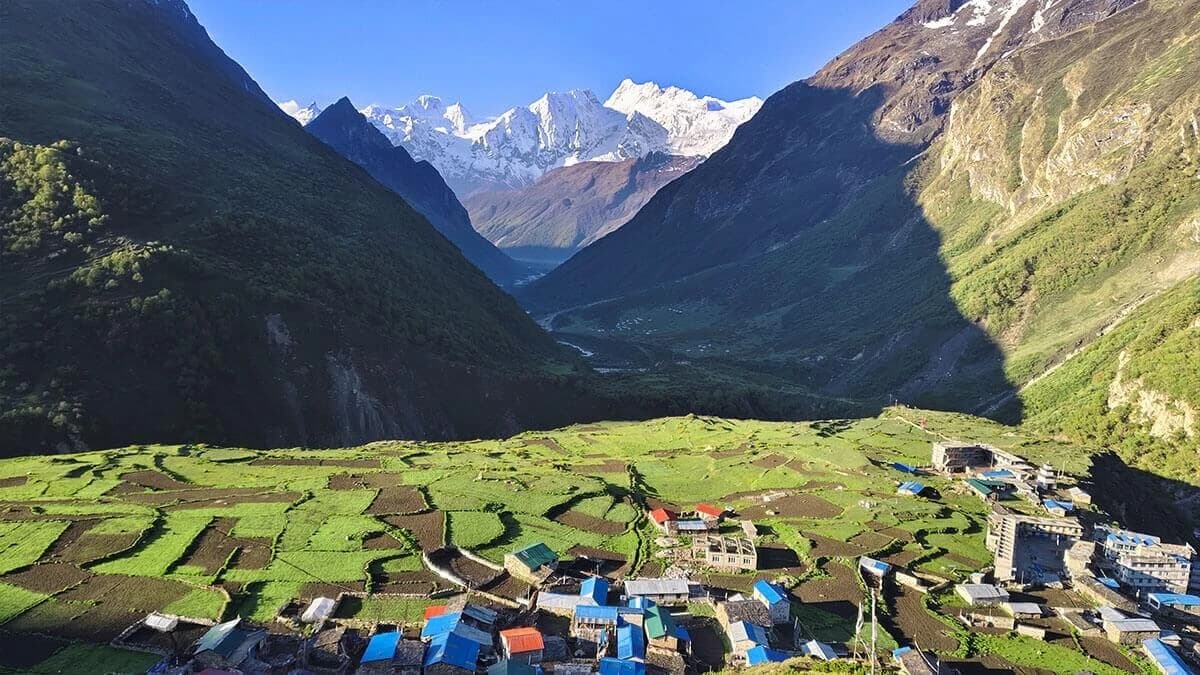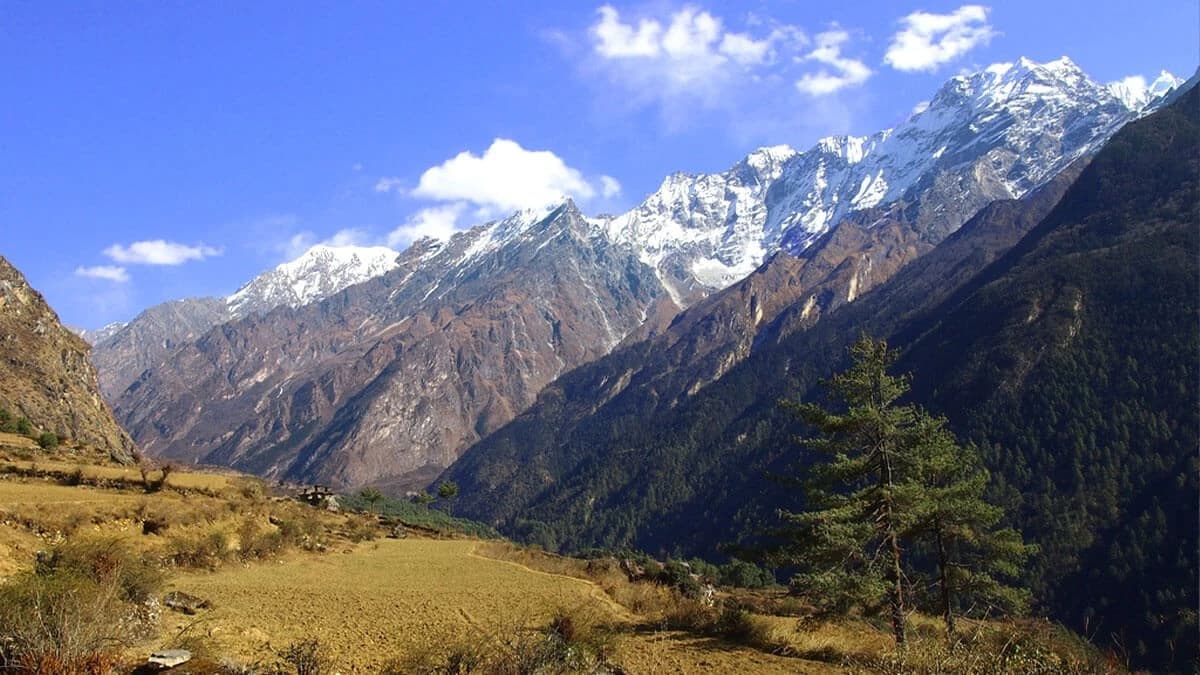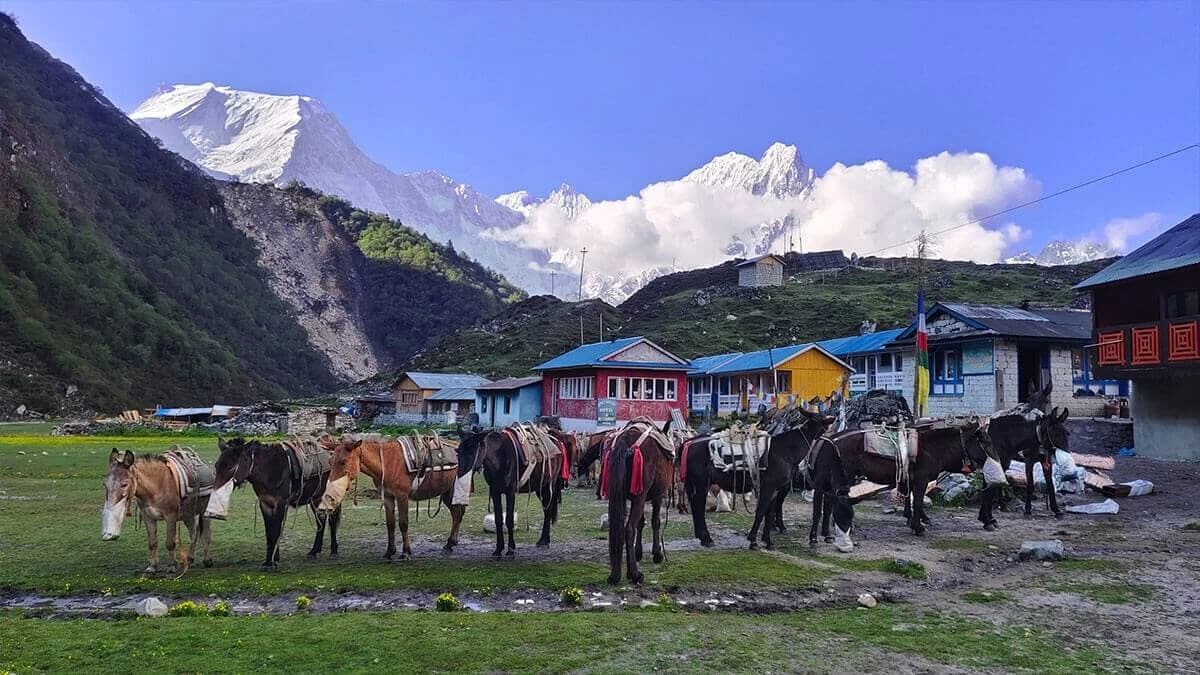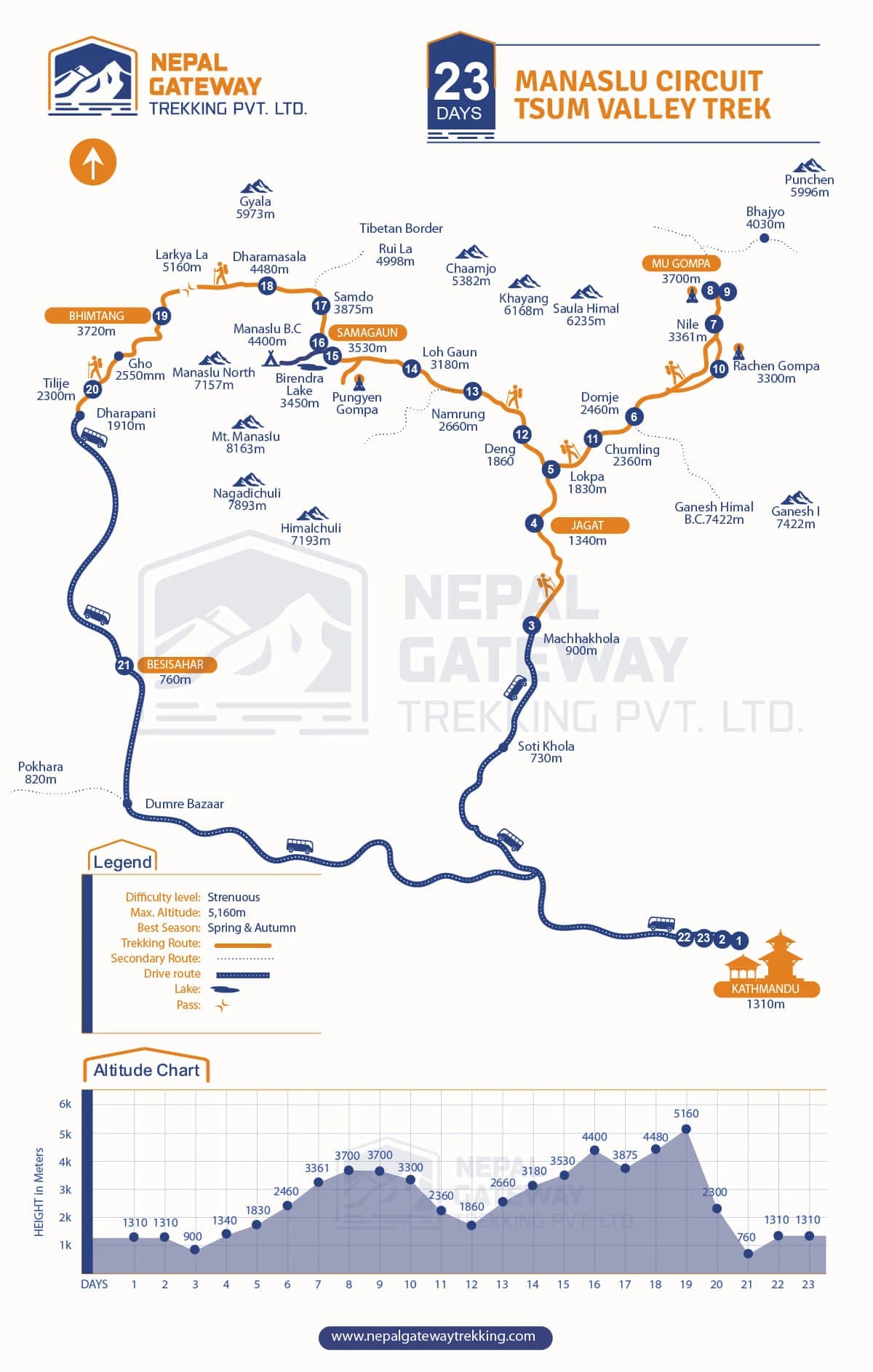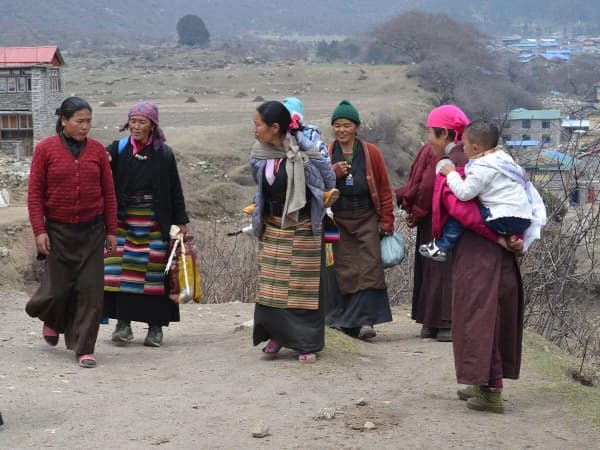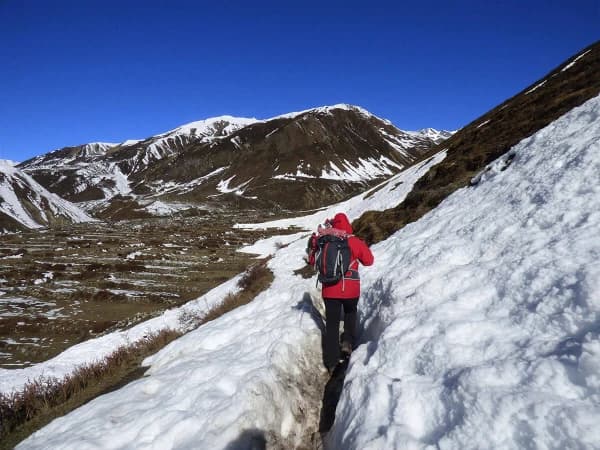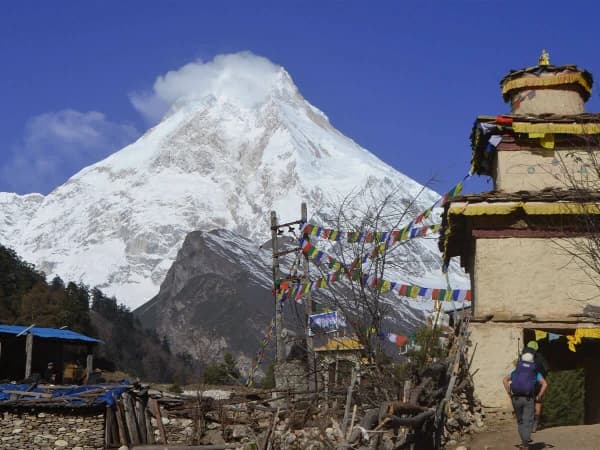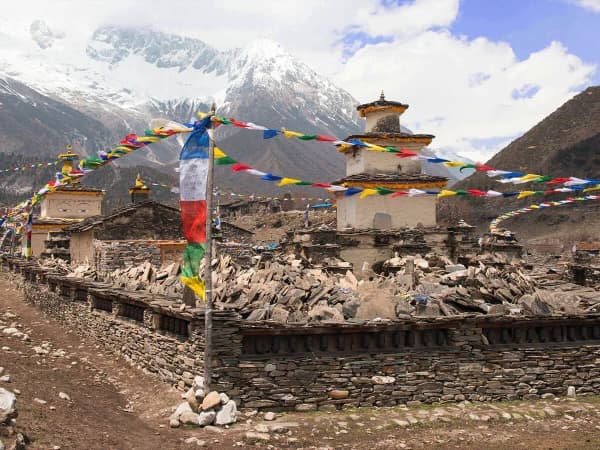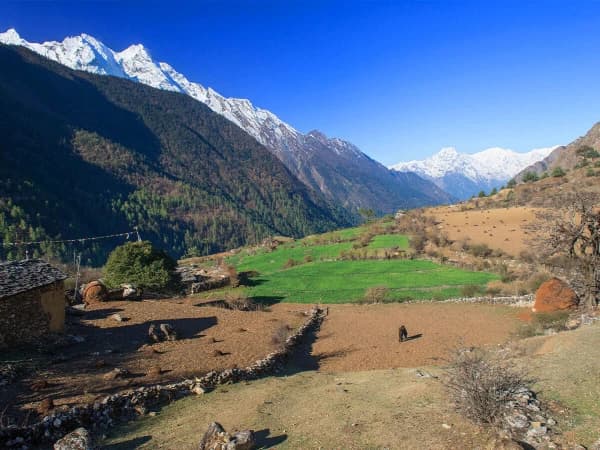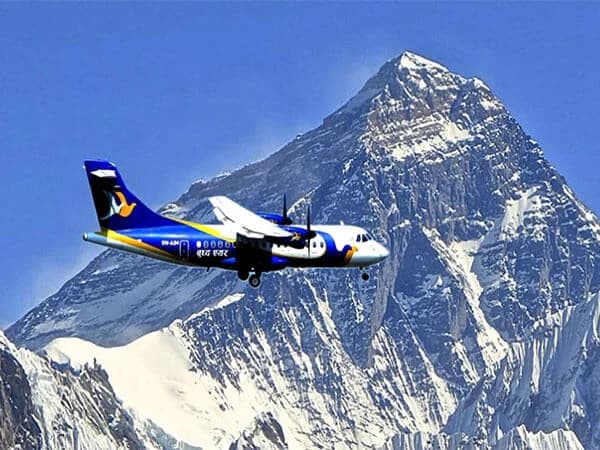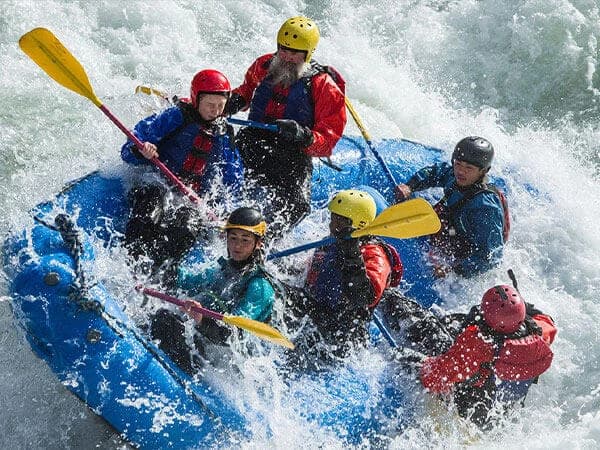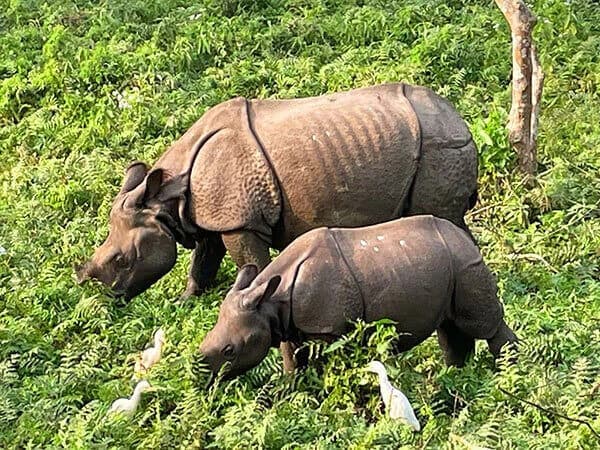Visiting Tibetan tales in the Tsum Valley, traversing the beautiful Manaslu to enjoy offbeat walking with the stunning majestic Himalayas on the Manaslu Tsum Valley Trek.
Manaslu Circuit Tsum Valley Trek
Manaslu Circuit Tsum Valley Trek is a classic Himalayan adventure that combines the iconic circuit around Manaslu with the mystical Tsum Valley. This extraordinary extension offers everything you’d expect from a high-altitude trek, from epic scenery to steamy jungles, intimate encounters, remote wilderness, Buddhist cultures, and breathless mountain passes.
The Manaslu Circuit Trek with Tsum Valley portrays Nepal’s diverse terrains and scenery. Starting at 870 meters in the subtropical lowlands of Machha Khola, the route meanders through traditional villages, terraced farmlands, narrow cliffs, alpine meadows, and glacial moraines, all the way across Larkya La Pass at 5,106 meters. Along the way, you’ll get to relish a few snowcapped giants, including Manaslu, Himalchuli, Cheo Himal, Himlung Himal, Ngadi Chuli, and Ganesh Himal.
Nestled close to the border with Tibet, both Manaslu and Tsum Valley were restricted to foreigners until a few decades back. Untouched by modernity, these hidden valleys reflect their distinct lifestyle, culture, and tradition with a strong influence of Tibetan Buddhism.
The primary inhabitants of these regions are Nubri, Tsumba, Bhutias, and Gurungs. The stone-built villages are often decorated with colorful prayer flags, mani walls, stone gates, and ancient monasteries. Along the route, you’ll visit some of the oldest Buddhist monasteries, including Mu Gompa and Rachen Gompa. Moreover, you’ll explore the mystical Milarepa Cave (Piren Phu Cave) to experience deep cultural and spiritual immersion.
Beyond the stunning landscapes and cultural experiences, this trek passes through two protected areas: the Manaslu Conservation Area and the Annapurna Conservation Area. Exploring these protected areas offers a unique opportunity to observe rare species of wildlife and native flora in their natural habitats.
Unlike the trails of Everest and Annapurna, the Manaslu Circuit Trekking with Tsum Valley remains a remote and isolated destination. This strenuous adventure is suitable for seasoned trekkers willing to immerse themselves in the raw beauty and deep-rooted culture of the Himalayas.
The Top Highlights of Manaslu Circuit Trek with Tsum Valley
- Conquer the mighty Larkya La Pass at 5,106 meters.
- Enter the restricted area of Manaslu and Tsum Valley.
- Explore the hidden settlements of Tsum Valley, including Chumling, Chekampar, and Nile.
- Visit the centuries-old Milerapa Cave, one of the most sacred landmarks in the Tsum Valley.
- Visit the ancient Buddhist monasteries at Mu Gompa and Rachen Gompa.
- Take an acclimatization hike to Manaslu Base Camp and Birendra Tal.
- Relish the unparalleled views of Manaslu, Himalchuli, Ganesh Himal, Cheo Himal, Himlung Himal, and Ngadi Chuli.
- Embrace solitude and experience the authentic wilderness in two of Nepal’s most remote regions.
Route Overview of Manaslu Circuit Trek with Tsum Valley
The adventure of Manaslu Circuit Trek with Tsum Valley begins with a scenic 9-hour drive from Kathmandu to Machha Khola. You’ll start your on-foot journey along the Budhi Gandaki River, past lush forests, suspension bridges, terraced farms, and narrow cliffs. You’ll enter the restricted area of the Manaslu region at Jagat.
From Jagat, the route climbs gradually to the village of Lokpa, the gateway to the hidden Tsum Valley. In the following few days, you’ll walk past several remote settlements, including Chumling and Chekampar. You’ll walk along the route marked by colorful prayer flags, mani walls, prayer wheels, and ancient monasteries to arrive at Nile, which is the last permanent village of Upper Tsum Valley. Along the route, you’ll visit the centuries-old Milarepa Cave to immerse yourself in the cultural aspect of the region.
You’ll have the first acclimatization day of Manaslu Circuit Trek with Tsum Valley at Nile. On this day, you’ll hike to the sacred Mu Gompa, nestled on a hilltop at 3,700 meters. Here, you’ll get to relish a stunning panorama of Ganesh Himal I, Ganesh Himal II, Manaslu, and Himalchuli.
After the acclimatization day, you’ll retrace the route towards Deng to rejoin the main trail of Manaslu Circuit. From here, the climb continues alongside Budhi Gandaki River, past dense forests and high gorges towards Namrung. Heading out of Namrung, the trail gently climbs through rhododendron forests towards the village of Shyala. You’ll continue on relatively rugged terrain, following the glacial moraine of Pungyen Glacier to arrive at Samagaun.
You’ll spend another acclimatization day at Samagaun. On this day, you’ll take an excursion to either Pungyen Gompa or the Manaslu Base Camp. After acclimatizing, the trek continues towards the windswept pastures of Samdo before heading to Dharmasala (Larya Phedi). Dharamshala marks the final camp before crossing the formidable Larkya La Pass.
Early the next morning, the trail climbs steeply to the summit of Larkya La Pass. The summit rewards you with a panoramic view of Himalayan giants, including Manaslu, Himlung Himal, Annapurna II, Kang Guru, and Cheo Himal. Descending from the pass, the trail navigates through a glacial moraine and loose scree sections towards Bhimthang.
Ultimately, the trek rejoins the popular Annapurna Circuit route at Dharapani. Here, you’ll end the on-foot adventure and take a local jeep to Besisahar. The following morning, you’ll catch a tourist bus from Besisahar to Kathmandu to conclude your Manaslu Circuit Trek with Tsum Valley.
Why the Manaslu Circuit Trek with Tsum Valley with Nepal Gateway Trekking?
- Nepal Gateway Trekking stands as one of Nepal’s leading trekking companies, boasting over a decade of experience in high-altitude treks and expeditions. Over the years, our team of experts has refined the itinerary of Manaslu Circuit Trek with Tsum Valley to include proper acclimatization days and side trips.
- We follow stringent safety protocols, ensuring good health of our clients and crew members. We provide trained staff, advanced first-aid kits, high-quality gear, and reliable emergency support for a safe and successful trek.
- Our experienced trekking guides have in-depth knowledge of the trails, weather conditions, and local culture, ensuring both safety and a rich trekking experience. They are also qualified to identify health emergencies and provide critical first aid treatments.
- We maintain an appropriate staff-to-trekker ratio of one crew member for every three trekkers to ensure better attention and support.
- We handle all logistics, including permits, transportation, accommodations, meals, and route planning, so that you can focus entirely on the trek without any stress.
- We make early reservations for accommodation in Kathmandu and throughout the route to avoid last-minute hassles and overcrowding.
- Our team prioritizes sustainable antiques and responsible waste management to reduce our carbon footprint and minimize plastic use.
- Our expert team tailors each trek based on your fitness level and desired adventure. We also provide customized services and private options for a more personalized experience.
- Our package includes an exclusive duffle bag and an official t-shirt for each client.
Itinerary
This is our standard and recommended Manaslu Circuit Trek with Tsum Valley itinerary.
Your adventure holiday in the Himalayas begins with a touchdown at Tribhuvan International Airport. Upon arrival, a representative from Nepal Gateway Trekking will greet you and transfer you to the hotel.
After checking in, you can take some time to recover from your journey, enjoy a hot shower, relax by the pool, and savor some local delicacies. Depending on your arrival time, you may have enough time to explore the immediate vicinity of the hotel and acclimate to the bustling streets of Kathmandu. You can even visit Kathmandu Durbar Square to see the city’s narrow alleyways, colorful markets, historical complexes, and ancient temples.
In the evening, you’ll have a short pre-trek briefing and team introduction at the hotel. Start the session by introducing yourself and getting acquainted with the guide and fellow group members. Later, your guide will discuss the trek details, including the itinerary, trail conditions, what to expect, and safety protocols. He will also make arrangements to distribute duffel bags and other freebies before calling it a night.
A free day in Kathmandu to recover from the journey and jet lag. This is a perfect opportunity to explore the bustling city, visit the world heritage sites, and savor a few local delicacies to get a taste of Nepali culture and lifestyle.
While you enjoy your leisure day, our team will make all the necessary arrangements to secure the trekking permits required for the Manaslu Circuit Trek with Tsum Valley.
In the afternoon, you’ll have a short group meeting for a gear check and final trek preparation to ensure everything is in order. If you’re missing any items or don’t have the necessary gear, you can head over to Thamel with your trekking guide for last-minute shopping. Thamel is the hub of outdoor shops, where you can purchase or rent all kinds of gear and supplies for trekking and expeditions.
Pro Tip: Please prepare and pack your trekking bags tonight, as you’ll be departing early tomorrow for the trailhead at Machha Khola.
After a hearty breakfast in the hotel, you’ll set off on a long, scenic drive westwards from Kathmandu to Machha Khola. You’ll follow the winding road of the Prithvi Highway that navigates alongside the torrential Trisuli River.
The route offers beautiful scenery of lush valleys, countryside settlements, terraced hillsides, small bazaars, and roadside tea shops. The road from Kathmandu to Dhading Besi is in decent condition for the most part, with smooth, asphalt roads. However, there are a few sections on the highway that are particularly poor due to ongoing road construction and expansion.
Beyond this point, the road becomes progressively rutted and challenging as it winds along the steep banks of the Budhi Gandaki River. On a clear day, you can see the southern slopes of Manaslu, Ganesh Himal, and Shringi Himal along the route.
You’ll arrive at your overnight destination of Machha Khola by late afternoon. Settle in at one of the best teahouses in the village and relax in the cozy dining area for the rest of the evening.
Today, you’ll begin your on-foot adventure on a gradual path from Machha Khola to Jagat. As you head out of Machha Khola, the trail gently winds up and down the narrow path carved on a stone cliff. After nearly two hours, you’ll cross a small suspension bridge over Thado Khola to reach the tiny village of Khorla Besi.
From here, the Budhi Gandaki Gorge narrows down even more with sheer cliffs on either side. You’ll follow the cliff path along the eastern bank to arrive at a small hot spring in Tatopani. After a refreshing break, the route passes through a short ridge before crossing a steel suspension bridge over the Budhi Gandaki River. Here, you’ll climb stone staircases through a short forested section to arrive at Dobhan.
The trail continues on rocky slopes and landslide areas towards Yarubagar, where you’ll cross a long cantilever bridge to arrive at the village of Jagat. This village marks the entrance point of the Manaslu Conservation Area.
On this day, you’ll enter the restricted area of Manaslu. You’ll begin the day by crossing a suspension bridge and climbing a ridge past the settlements of Salleri, Sirdibas, and Ghatta Khola. On a clear day, this route rewards you with a breathtaking view of the Shringi Himal.
The trail meanders along the riverbanks before crossing the Budhi Gandaki River via a long suspension bridge to enter the open valley that leads to Philim. As you head out of Philim, the trail grows quieter and wilder, deep into the dense bamboo forest toward Ekle Bhatti.
A few kilometers from Ekle Bhatti, you’ll reach a crossroad that diverges the route of Tsum Valley and Manaslu Circuit. You’ll take the right-hand path that leads to Tsum Valley and continue the walk through a steep, uninhabited forest. After a short climb, you’ll arrive at the small, peaceful village of Lokpa to spend the night.
Start your day with a delicious breakfast at the teahouse in Lokpa, enjoying the stunning view of Baudha Himal and Ganesh Himal VI. After breakfast, you’ll head out of the serene village of Lokpa with a gradual descent towards the Lungwa River Valley. From here, the trail passes deeper into the woods of pine and rhododendron.
The path gradually navigates up and down the thick forest, crossing a few small bridges. The route between Lokpa and Chumling is entirely uninhabited, with no settlements or teahouses along the way. After a few hours, you’ll cross a long suspension bridge over Syar Khola to reach the beautiful Chumling village.
Clustered with stone-built houses, fluttering prayer flags, colorful chortens, and historic monasteries, Chumling is the first village that offers an authentic feel of the Tsum Valley. If you arrive in Chumling early, you can hike to the upper part of the village to visit three ancient monasteries, including Panago Gumba, Mani Dhungyur, and Gurwa Gumba. Although short, this excursion offers a deeper insight into the spiritual heritage of the Tsum Valley.
Today, you’ll enter the Upper Tsum Valley, located in the inner Himalayas. The path departing Chumling follows Syar Khola through thick forest. You’ll walk past several traditional villages, including Ripchet and Tumje, where livelihoods remain untouched by modernity.
As you continue the steady climb, the snowy peak of Ganesh Himal slowly emerges through the clouds. The landscape changes dramatically from a narrow river trail to a wide, open valley as you arrive at the village of Chekampar (locally known as Chhokangparo).
Located at 3,030 meters, Chekampar is the largest village in the whole of Tsum Valley. This mountain settlement is clustered with typical stone houses, terraced fields, grazing yaks, and ancient monasteries. On a clear day, you’ll get to relish the stunning scenery of Ganesh Himal and Himalchuli from the village.
After breakfast in Chekampar, you’ll continue the trek on a relatively gradual path. The trail spreads dramatically, revealing the panoramic views of Syar Khola Valley and distant settlements clinging to the mountainsides.
Upon arriving at Lamagaon, you’ll visit the Milarepa Cave (locally known as Piren Phu Cave). Piren Phu is one of the most sacred landmarks in the Tsum Valley. Here, you can see a centuries-old rock imprint said to be the footprint of Milarepa, the 11th-century Tibetan yogi and spiritual poet. Additionally, this remote, rocky cave is adorned with richly painted Buddhist murals, stone-carved artistic scripts, ancient manuscripts, and colorful prayer flags.
After a short visit to this sacred cave, you’ll cross a small suspension bridge and continue the walk beyond several tiny villages to reach Nile. Nestled at 3,361 meters, Nile marks the last permanent settlement of the Upper Tsum Valley. This tranquil settlement, perched on the western bank of Syar Khola, is surrounded by Tibetan-style stone houses and fluttering prayer flags.
Today marks a special day on the Manaslu Circuit Trek with Tsum Valley, as you’ll hike to Mu Gompa, one of Tsum Valley’s highest and most significant Buddhist monasteries. You’ll start the day a bit later than usual, enjoying a relaxed morning and a late breakfast.
Leaving Nile, the trail climbs gently through dry, arid Trans-Himalayan terrain, offering stunning scenery of the surrounding mountains and landscapes. The trail from Nile to Mu Gompa is mostly flat with gentle slopes, except for the final stretch. The last 20 minutes of the hike include a steep uphill section, just below Mu Gompa.
Mu Gompa sits on a solitary hilltop at 3,700 meters, surrounded by snow-capped mountains, deep valleys, and glaciers. The outer premises of the monastery reward you with a breathtaking panorama of Ganesh Himal I, Ganesh Himal II, Manaslu, and Himalchuli. Moreover, this centuries-old monastery holds many ancient treasures, including a 125-year-old stone sculpture, colorful paintings, antique thangkas, and age-old Tibetan books.
After a spiritual cleansing at Mu Gompa, retrace your steps back to the Nile for the overnight stay.
On this day, you’ll begin your return journey from Upper Tsum Valley, with a gradual descent from Nile to Chhekampar. The walk back to Chekampar follows the same route, passing through the quaint settlements of Chhule, Pagdun, Phurbe, and Lamagaon.
Along the way, you’ll make a brief stop at the historic Rachen Gompa/Nunnery. Founded in 1905 by Lama Kunga Tsultrim Dorje, this sprawling nunnery is one of the largest in the region, housing around 100 Buddhist scholars.
After a short exploration, you’ll continue the descent through the familiar yak pastures, chortens, and mani walls towards Chekampar. Although you’ll follow the same route, the return direction unveils unseen mountain vistas and valley perspectives. After about 7 hours of gentle downhill, you’ll arrive at the beautiful settlement of Chekampar.
Your day begins with a warm and hearty breakfast at Chhekampar before retracing the route to Chumling. As you head out of Chekampar, the spacious, open fields soon turn into a narrow path. If the sky remains clear, you’ll be greeted with breathtaking views of Ganesh Himal and Baudha Himal throughout the day.
The trail drops gradually towards Serpu Khola, passing several traditional settlements clustered with stone houses, chortens, mani walls, and prayer flags. Upon crossing a small suspension bridge over Serpu Khola, you’ll enter a densely forested trail that continues until you reach Chumling.
You’ll spend the night at a cozy teahouse in Chumling, embracing the beautiful scenery of the lush green valleys, terraced fields, and towering mountains. After a few days in the higher valleys, this tiny Tsumba settlement feels ever welcoming and full of life.
Today, you’ll walk out of the Tsum Valley and enter the main trail of the Manaslu Circuit. First, you’ll retrace your steps from Chumling to Lokpa along the riverbanks of Syar Khola. Upon reaching Lokpa, the trail drops steeply towards the grassy riverbed of Budhi Gandaki. The distant view of Ganesh Himal and Manaslu is particularly captivating along this route.
After crossing a suspension bridge over the Budhi Gandaki River, the trail gradually ascends on a narrow, rocky trail. After several hours of climbing through quaint villages and lush woodlands, you’ll reach the small valley of Nubri. Here, you’ll cross a small bridge and continue on a steep path along the bamboo shrubs.
You’ll notice a stark change in the landscape as the trail winds through rocky hills, deep gorges, and high cliff-faces. After 8 to 9 hours of a gentle climb, you’ll arrive at the small settlement of Deng, tucked onto a narrow ledge between sheer cliff walls.
The trail from Deng to Namrung takes you deep into the highlands of the Manaslu region. The day begins with a slow ascent to Bihi Phedi. From here, the trail meanders in and out of the valley canyons, before crossing the Budhi Gandaki River to reach Ghap village. You’ll start to notice Tibetan-influenced cultures, language, and lifestyle around this region.
As you head out of Ghap, the trail becomes much steeper, winding through dense pine and rhododendron forests. After navigating several suspension bridges over the Budhi Gandaki River, the stone-built teahouses of Namrung appear in the distance.
At 2,630 meters, Namrung marks the entry point to the Upper Nubri region. On a clear day, this charming village rewards you with a stunning vista of Ganesh Himal and Himalchuli.
As you exit Namrung’s stone gate, the trail climbs gently through lush rhododendron forest. You’ll walk past several traditional settlements, including Lihi, Banjam, and Sho. At Sho village, you’ll get a striking glimpse of Mt. Manaslu and Manaslu North.
You’ll pass several colorful mani walls, whitewashed chortens, and Buddhist monasteries to reach the village of Lho. Here, you’ll make a brief stop to visit the Ribum Monastery. Tucked in the small hilltop overlooking the entire Lho village, this ancient monastery stands as a significant landmark of rich spirituality and heritage.
The hidden valley of Shyala is only a few hours away from Lho. This serene valley offers a peaceful atmosphere, distinct from the rest of the world, adorned with its Tibetan-style stone houses, yaks pastures, and fluttering prayer flags. Moreover, it is enclosed by towering mountains, including Manaslu, Himalchuli, and Ngadi Chuli, on all sides.
The walk from Shyala to Samagaun is short in distance but rich in beauty. Leaving Shyala, the route passes through a traditional stone gate and a long mani wall adorned with carved prayers. The first section of the trek is a gradual climb towards Shya La Pass. As you approach the top, you’ll be rewarded with a superb panorama of Ganesh Himal, Himalchuli, Manaslu, and Pungen Glacier.
Descending the main trail, you’ll follow the lateral moraine of Pungyen Glacier to reach Samagaun. The village offers a spectacular view of the granite pyramid of Mt. Manaslu. The altitude at Samagaun is 3,530 meters. It is one of the largest and most significant settlements on the Manaslu Circuit. The atmosphere around the village is enchanting, with clusters of traditional stone houses, yak fields, mani walls, friendly locals, a Buddhist stupa, and a centuries-old monastery.
Today’s trek concludes in Samagaun by lunchtime, with the afternoon free for rest or exploration. You can sit back in the cozy dining room of your teahouse, or you can explore around the village and visit Nubri Pema Decho Ling Monastery.
Today, you have a free day in Samagaun to rest and acclimatize to the high altitude. There are several hiking options near the village to keep you active throughout the day.
You can start the day with a relaxed morning and a late breakfast. After breakfast, you’ll take a day trip to either Pungyen Gompa or Manaslu Base Camp.
Pungyen Gompa is a 6-hour round trip that combines the natural, cultural, and spiritual aspects of the Manaslu region. Nestled atop a hill at 3,980 meters, the monastery offers a close-up view of Manaslu and Pungyen Glacier. If the timing is right, you can also observe daily rituals, such as monks chanting, praying, making offerings, and playing sacred instruments, inside the monastery.
On the other hand, a hike to Manaslu Base Camp is a strenuous 8-hour round trip from Samagaun. At 4,940 meters, the base camp serves as the gateway for climbers aiming to conquer the mighty Manaslu, the world’s eighth-highest mountain. Manaslu Base Camp rewards you with uninterrupted views of Manaslu, Himalchuli, Ngadi Chuli, and Ganesh Himal.
It is clustered with rugged terrain, rock formations, glaciers, and icefalls, adding more alpine elements to the dramatic scenery.
After a rejuvenating rest day at Samagaun, you’ll continue the trek towards Samdo. As you leave behind the stone houses and open fields of Samagaun, the trail gently drops to the riverbanks of Budhi Gandaki. You’ll follow a narrow path under the shade of juniper and birch trees alongside the river.
You’ll cross a small wooden bridge over the Budhi Gandaki River at Kermo Kharka. From here, the trail becomes rough and steep, with the trees giving way to alpine terrain and mountains. As you continue the gradual climb, you’ll arrive at Samdo.
The walk from Samagaun to Samdo is only 3 to 4 hours. Although a short day, you’ll notice a stark difference in the landscape and lifestyle between the two villages. It embraces well-preserved cultural authenticity and dramatic Himalayan vistas.
Another short day from Samdo to Dharmasala before crossing the formidable Larkya La Pass. Leaving Samdo, you’ll cross a small stream running down from Gya La via a wooden bridge and begin a gentle climb. Along the way, you’ll cross the ruins of the historic Larkya Bazar, an ancient bazaar which once had a thriving trade with Tibet.
The trail winds around the valley of Salka Khola and gradually ascends towards Dharmasala. This teahouse settlement, also known as Larkya Phedi, has a few small and basic lodges. Check in at one of the cozy teahouses, stay warm, and enjoy some hot meals.
The rest of the afternoon is free for acclimatization and recovery. You have the option to explore the nearby Larkya Glacier or relax at the teahouse and prepare for the big day tomorrow.
Crossing the formidable Larkya La Pass is the most strenuous yet rewarding experience in the Manaslu Circuit Trek with Tsum Valley. Today, you’ll head out of Dharmasala early in the morning, under a starlit sky. So, keep your headlamps and trekking poles handy for this day.
You’ll begin the journey with a short climb above the teahouse to reach the ablation zone of the Larkya Glacier. Here, you’ll walk past small frozen lakes with the faint views of Cho Danda and Larkya Peak, reflecting on the pre-dawn sky.
The trail gradually meanders across rocky boulder fields and crests several ridgelines en route to the summit of Lakya La Pass. After nearly four hours of rigorous climbing from Dharmasala, you’ll arrive at the summit of Larkya La Pass, adorned in fluttering prayer flags.
The summit rewards you with an otherworldly panorama of Himalayan peaks, including Manaslu, Himlung Himal, Annapurna II, Kang Guru, and Cheo Himal. After a brief stop, continue with the steep descent over a glacial moraine and loose scree sections. Although demanding, the descent from Larkya La Pass is exceptionally scenic, offering striking views of Pongkar Tal, Nayamlo Tal, and the Salpu Danda Glacier.
After a few hours, the trail becomes relatively gradual, as the valley broadens up to reach the alpine village of Bhimthang. You’ll conclude the long, hard day with a hot meal and cozy stay at a local teahouse in Bhimthang.
After breakfast, you’ll begin the day by traversing across the high pastures of Bimthang. The trail descends through a narrow ridge towards the riverbanks of Dudh Khola. Here, you’ll cross a small wooden bridge and enter the thick rhododendron forest towards Karche.
Along the route, you’ll be greeted with the stunning panorama of Manaslu, Phungi Peak, Cheo Himal, and Himlung Himal. The trail continues along the lush fields before arriving at the landslide section. After carefully crossing the landslide zone, you’ll make a steep climb over a ridge decorated with colorful prayer flags to reach the village of Gho.
After a short break, the trail drops gradually through beautiful rhododendron and pine forest. You’ll continue the gradual walk for another hour and a half to reach your overnight destination of Tilje.
Your final day of the Manaslu Circuit Trek with Tsum Valley begins with a short walk from Tilje to Dharapani. Initially, you’ll cross a small stream beyond the teahouses and follow the dirt track towards the Marsyangdi River. After two hours of gradual descent, you’ll cross a steel suspension bridge, near Thonje, and climb a series of stone staircases to reach the bustling town of Dharapani.
After a short break at Dharapani, you’ll catch a local 4x4 jeep and descend towards Besisahar. The four-hour drive from Dharpani to Besisahar traverses rough and unpaved roads, so expect frequent bumps and dust clouds.
After breakfast, you’ll catch a comfortable tourist bus from Besisahar and head towards Kathmandu. Typically, the tourist buses depart from the station around 7:00 AM. This 5-6 hour drive takes you across lush valleys, terraced fields, and roadside bazaars.
You’ll arrive in the bustling city of Kathmandu by early afternoon. Upon arrival, you’ll check in at the hotel and enjoy a free afternoon with a hot shower and relaxation by the pool.
In the evening, you have the option to walk around the streets of Thamel, buy souvenirs, and dine out at a fancy restaurant.
This is your final day in Nepal. Start the day with a scrumptious breakfast at the hotel. After breakfast, pack your bags and prepare your documents for the flight.
Our representative will arrive at your hotel exactly three and a half hours before your flight. He’ll provide you with a private transfer to Tribhuvan International Airport for your final departure.
Nepal Gateway Trekking wishes you a safe flight back home. We look forward to seeing you soon. Until our next adventure!
Dates & Availability
Private tripCost Includes
- All ground transportation as per the program, including complimentary airport pickups and drop-offs by private vehicle.
- Three nights’ accommodation at a three-star category hotel in Kathmandu, inclusive of breakfast.
- Three meals (breakfast, lunch, and dinner)
- Twin-sharing accommodations during the trekking.
- One highly experienced English-speaking & friendly trekking guide
- Required porters (one porter between two trekkers), including their expenses.
- Tsum Valley and Manaslu Circuit trekking special permit fee.
- Annapurna and Manaslu conservation area permits. Please bring two passport-size photos for the permit.
- Tsum Valley + Manaslu Circuit Trekking Map.
- Nepal Gateway Company T-shirt and duffle bags.
- Local fresh fruits as dessert after dinner.
- First aid kit with an oximeter.
- Evacuation assistance, if needed.
- All government taxes.
- Office service charge.
Cost Excludes
- Lunches and dinners in Kathmandu.
- Your travel insurance.
- Nepal entry visa fee.
- Your international flight ticket to/from Kathmandu.
- All kinds of hot drinks (teas, coffees, and hot waters) during the Manaslu Circuit Tsum Valley Trek.
- Cold drinks (mineral water, Coke, Sprite, and Fanta) and alcoholic beverages on trekking.
- Your personal nature expenses, equipment, and medical kit.
- Hot shower, internet, and phone call unless it is free.
- Donations to schools, monasteries, etc.
- Battery charging fees for cameras, mobile phones, laptops, etc.
- Snacks and desserts (apple pies, chocolate pies, chocolate bars, etc.).
- Tipping to field staff. (Tipping is not mandatory but expected.).
- Extra accommodations in Kathmandu.
Good To Know
Manaslu Tsum Valley Trek Cost
Our combined itinerary for the Manaslu Circuit and the Tsum Valley Trek spans 23 days, with a package cost of USD 1,590 per person. This all-inclusive package covers accommodation, transportation, meals, and full logistical support to ensure a hassle-free adventure.
Your fees primarily fund the local guides and porters who provide navigation, safety support, luggage transport, and cultural insights throughout the trek. Additionally, it covers critical operational expenses, such as staff insurance and emergency preparedness.
A substantial portion of the costs is allocated for your accommodation, meals, and transportation. The package includes a 3-star hotel in Kathmandu and teahouse accommodation during the trek. The meal plan includes breakfast in Kathmandu and full board during the trek. Additionally, the package covers the cost of all necessary permits and documents.
Note that the total cost of the Manaslu Circuit Trek with Tsum Valley varies depending on several factors, including group size and trek duration. If you’re travelling in a small group, we offer a special discount up to USD 100 per person, depending on the group size.
We also offer tailored upgrades, including hotel upgrades, private jeep transfers, guided cultural tours, and additional acclimatization days. Please let us know your preferred travel dates, group size, and specific requirements (if any) so we can customize the experience that matches your comfort level and budget.
Manaslu Circuit Trek with Tsum Valley Permit
Trekking in the Manaslu Circuit and Tsum Valley involves walking through several restricted and protected areas. The government of Nepal has implemented strict permit regulations to control tourism, preserve local cultures, and conserve the environment in these regions.
To trek in the Manaslu Circuit and Tsum Valley, you must obtain four permits.
Manaslu Restricted Area Permit
Required for: Accessing the restricted area of the Manaslu region, stretching from Jagat to Sama Gaun. The permit can only be obtained through a registered trekking company and requires a group of at least two trekkers. Solo trekking is strictly prohibited in this region.
Cost
September to November: US$100 per person for the first seven days; US$15 per person for each additional day.
December to August: US$75 per person for the first seven days; US$10 per person for each additional day.
Manaslu Conservation Area Project
Required for: Entry into the Manaslu Conservation Area. The permit fees are used to fund conservation and development programs in the Manaslu region, including trail maintenance, waste management, and wildlife conservation.
Cost: NPR 3,000 per person for foreigners and NPR 1,000 for SAARC nationals.
Tsum Valley Restricted Area Permit
Required for: Trekking in the restricted zones of Tsum Valley. Similar to MRAP, this permit can only be obtained through a registered trekking company and requires a minimum of two trekkers.
Cost
September to November: US$40 per person for the first seven days; US$7 per person for each additional day.
December to August: US$30 per person for the first seven days; US$7 per person for each additional day
Annapurna Conservation Area Project
Required for: Entry into the Annapurna Conservation Area. Once you exit the Manaslu region, you’ll enter the Annapurna Conservation Area, typically through Dharapani. The permit fees help support conservation, tourism sustainability, and infrastructure development in the Annapurna region.
Cost: NPR 3,000 per person for foreigners and NPR 1,000 for SAARC nationals.
When is the Best Time for Manaslu Circuit Tsum Valley Trek?
Like most treks in Nepal, the best time to do the Manaslu Circuit Trek with Tsum Valley is during the autumn and spring seasons. These periods offer stable weather, clear mountain views, and ideal conditions for trekking.
Autumn, in particular, brings the best trail conditions, as seasonal rains wash away dirt, debris, and loose rocks. This makes the trekking path cleaner, providing stable footing and reducing the risk of landslides. The weather in autumn typically remains dry and stable, with mild daytime temperatures and cool, crisp nights.
With stable weather and superb visibility, this season presents the ideal conditions for crossing the Larkya La Pass. Besides that, the mountains are at their absolute best in autumn. You can enjoy the unobstructed views of Manaslu, Himalchuli, Ngadi Chuli, and Ganesh Himal throughout the day.
Spring, on the other hand, brings a pleasant combination of mild temperature, blooming rhododendrons, and a vibrant environment. This is the favorite time of year for wildlife spotters and bloom chasers. Most spring days begin with crisp air and clear skies, offering spectacular mountain scenery.
However, the afternoons often bring thick cloud cover, disrupting the visibility and weather conditions. It is advisable to begin the Larkya La crossing as early as possible, as the afternoon weather in the high mountains can shift quickly during spring.
Winter brings harsh conditions for trekking, especially in the upper regions of Manaslu and Tsum Valley. While the daytime temperatures are tolerable, the nighttime temperatures can drop below 20°C. Due to extreme temperatures and heavy snowfall, most villagers from high altitudes migrate to the lower areas.
It is possible to trek to Manaslu and Tsum Valley in winter, but only with proper preparation and high-end gear for expedition-style camping. During the peak winter season, the route to Larkya La Pass can become impassable due to thick snow and extreme weather conditions.
Monsoon is often considered the least favorite time to trek in the Himalayas of Nepal. It is due to continuous rainfall, obstructed mountain views, and unstable weather conditions. Although Manaslu and Tsum Valley lie in the rain shadow of the Himalayas, the lower section of the trek will be rain-soaked, slippery, and full of leeches. Additionally, there are several landslide-prone areas in this region, which can be dangerous to cross during the monsoon.
How difficult is the Manaslu Circuit Trekking with Tsum Valley Route?
The Manaslu Circuit Trekking with Tsum Valley route is a strenuous adventure in the high Himalayas of Nepal. Considering its high altitude, rugged terrains, and remote settlements, this trek is best suited for seasoned trekkers. Although the trail does not require technical skills, it includes steep ascents, narrow ridges, rocky terrains, and high mountain passes.
The biggest challenge of the Manaslu Circuit Trek with Tsum Valley is the altitude! On a 23-day itinerary, you’ll spend most of the night over 3,000 meters. The most challenging section of this trek is crossing the formidable Larkya La Pass at 5,106 meters. At such elevation, you’re under constant risk of high-altitude sickness. Therefore, it is crucial to acclimate properly, maintain a steady pace, and stay hydrated.
The Manaslu Circuit Trek with Tsum Valley requires 6 to 8 hours of walking for 18 to 19 days. Although the route is navigable, there are a few long and exhausting stretches between the villages. Compared to popular treks like Everest or Annapurna, the trails of Manaslu and Tsum Valley are less developed, with rocky paths, landslide sections, and narrow cliffside walks. Likewise, the teahouses and lodges are also very basic, with small rooms, shared toilets, no in-room heating, and occasional power outages.
You’ll have to deal with extra setbacks if you plan your trek during monsoon or winter. The weather in the upper section of the treks can be extreme during these months, with excessive snowfall, slippery trails, strong winds, and occasional snowstorms. Crossing Larkya La Pass can be extremely difficult during these months.
Training for Manaslu Circuit Trek with Tsum Valley
Manaslu Circuit Trek with Tsum Valley is a physically demanding, high-altitude trek that tests your endurance to the core. You’ll need more than just dedication to tackle the rugged terrains, long days, high altitude, and steep climbs. You need a serious preparation and training routine!
Here is a simple training program to prepare for the Manaslu Circuit Trek with Tsum Valley.
Cardio Conditioning
Your primary focus in this training program should be on building cardio endurance for better stamina and improved heart health. Begin with a 30-minute session of low-impact activities, such as running, brisk walking, cycling, stair climbing, or swimming.
Aim for at least 2 to 3 cardio sessions per week in the early stages. As your endurance improves, gradually increase the intensity and duration of your cardio workouts to more intense, hour-long sessions.
Strength Training
It is essential to have a strong body and legs to do the Manaslu Circuit Trek with Tsum Valley. Therefore, incorporate workouts that specifically target strengthening the legs, core, and hips to carry a heavy backpack and enhance balance on uneven terrain.
Aim to do at least two to three strength training sessions per week with three sets of 15 to 20 repetitions on each exercise. Begin with lightweight exercises and gradually increase the weights and intensity as you progress.
Altitude Preparation
One of the best ways to prepare for the Manaslu Circuit Trek with Tsum Valley is by hiking to higher elevations and spending a decent amount of time acclimating your body. Look for hiking routes with similar terrains and elevation gains around your hometown and make a habit of hiking weekly or bi-weekly for better adaptability.
However, if there are no hiking trails with high-altitude conditions near your hometown, we recommend practicing different breathing techniques and engaging in regular aerobic workouts. You can also use a hypoxic training device to simulate high-altitude conditions and enhance your body’s performance and endurance.
Flexibility Workouts
Having good flexibility and joint mobility is a significant advantage for high-altitude treks. Incorporate a few dynamic stretches and yoga into your training regimen for better flexibility and balance.
Additionally, these exercises improve your overall agility, enhance blood circulation, and boost muscle recovery. You should add at least four to five stretching and yoga sessions per week. Over time, you can even add a short 15- to 20-minute stretching session before each workout.
Gear Familiarization
It is crucial to test your gear months before the trek to get comfortable with it. Start carrying a backpack with a small weight on your training hikes and walks. Once you get used to it, you can gradually increase the weight of the backpack to make it equivalent to the weight you’ll be carrying on the trek.
It’s a good idea to wear your hiking boots everywhere. Breaking in your hiking boots before the trek prevents blisters, ensures comfort, and overall performance on the trail. Additionally, we recommend you practice layering and adjusting your gear in various weather conditions during training hikes.
Mental Preparation
The Manaslu Circuit Trek with Tsum Valley can be mentally challenging, even for seasoned trekkers. Therefore, it is crucial to build patience and prepare yourself mentally for potential difficulties, such as high altitudes, rugged terrain, cold temperatures, repetitive meals, long days, and basic facilities.
Read guidebooks and articles thoroughly to gain a comprehensive understanding of every aspect of the route and what to expect. Visualize all the challenging moments you’ll presumably encounter on the trek and think of how you’ll endure them. We encourage you to practice mindfulness wherever possible to cultivate a positive mindset and develop effective coping strategies.
Rest and Recovery
It is essential to take enough time to rest and recover your body after intensive workout sessions. Understand this: your body breaks down much faster while overtraining than it does while undertraining. So, schedule at least one to two rest days from intensive activities every week.
On your rest day, indulge in light activities like yoga, meditation, and stretching to stay focused. Additionally, it is essential to get enough sleep, eat a balanced diet, and stay hydrated to boost your training and recovery.
Acclimatization and Safety
Manaslu Circuit Trek with Tsum Valley involves spending several nights above 3,000 meters. It also requires crossing the mighty Larkya La Pass at 5,106 meters.
Acute Mountain Sickness (AMS) is the biggest threat on any trek above 3,000 meters, and this trek is no different. Most people begin to experience the effects of altitude at this point, and by 4,000 meters, almost everyone will feel faster breathing, a higher heart rate, and even mild symptoms, such as headaches and difficulty sleeping.
Note that everybody responds to high altitude differently. While some individuals may adjust to the altitude quickly, others may take longer to adjust. Therefore, it is essential to give your body enough time to adapt before heading to a higher altitude. Additionally, you should consider several factors to minimize the risk of AMS and ensure your safety at high altitudes.
Things You Should Do to Acclimatize
- Ascend gradually at a comfortable pace. Once you’re above 3,000 meters, aim for 400 to 500 meters elevation gain per day. On shorter days, opt for evening hikes to higher elevations to help your body acclimate more quickly.
- At altitude, you lose water twice as fast through respiration and sweat. Therefore, keep yourself hydrated by drinking at least 3 to 4 liters of water per day. We recommend adding electrolyte tablets to your water to help your body retain water more effectively. Check your urine color regularly to monitor your hydration levels.
- Add at least two to three acclimatization days on your itinerary. Make the most of this day by hiking to a high altitude to acclimate your body to the thin air. You should also make time for rest and recovery, as proper rest aids acclimatization.
- It is common to lose your appetite at high elevations. Therefore, it is advisable to consume carb-heavy meals for proper digestion, adequate energy, and improved oxygenation. Keep your favorite snacks within reach to fuel your body frequently during small breaks.
- At altitude, dressing in layers helps to regulate body temperature. So, pack your bags for the right season. Always pack the essentials, such as hiking boots, a down jacket, a waterproof jacket, and a windbreaker to keep your body warm, dry, and protected.
- Alcohol, caffeine, tobacco, and other stimulants affect blood pressure, increase heart rate, and worsen dehydration. It is advisable to avoid these substances throughout the trek and maintain complete control over your body.
- Don’t push through warning signs and mild symptoms. If you notice any symptoms, inform your guide or crew member immediately to prevent the condition from worsening. Heed your guide’s advice on pacing and rest stops as they know these mountains best.
Travel Insurance
Manaslu Circuit Trek with Tsum Valley is a high-altitude adventure in the remote Himalayas of Nepal. It involves crossing a mountain pass over 5,000 meters and spending several nights at elevations above 3,000 meters. Therefore, it is mandatory to obtain a valid travel insurance policy to join this adventure holiday with Nepal Gateway Trekking.
When purchasing a travel insurance policy, select one that covers the costs of helicopter evacuation and emergency medical treatment. Additionally, your insurance policy must include refunds for trip cancellation and cover the cost of personal belongings in the event of theft or damage.
Make sure your insurance policy includes coverage for high-altitude (up to at least 5,500 meters) and adventure activities you plan to participate in during the Manaslu Circuit Trek with Tsum Valley.
Accommodation
You’ll spend three nights in a luxurious 3-star hotel on a BB basis in Kathmandu. Tucked in the heart of Thamel, this luxury hotel offers air-conditioned rooms, en-suite bathrooms, 24-hour hot water, and high-speed internet.
While on the trek, you’ll stay in cozy teahouses and mountain lodges. You’ll find a stark contrast between the accommodation in Tsum Valley and Manaslu Circuit. The teahouses in Tsum Valley are basic with limited amenities. The rooms are often small with twin or triple beds, pillows, foam mattresses, and blankets. Almost all teahouses in this region have shared toilets.
The lower section of the Manaslu Circuit offers decent accommodation. Although the amenities have improved significantly over the years, they are still subpar compared to those found at Everest or Annapurna. There are limited teahouses in the upper section of the Manaslu Circuit, and they are extremely basic.
The teahouses in Manaslu Circuit and Tsum Valley do not offer heated blankets or in-room heating facilities. Like most lodges in the mountains, they have a common dining area, typically lit by an evening fire, which keeps the area warm and cozy. The dining area is usually the most spacious yet crowded section in the teahouses, as most trekkers gather here for meals, socializing, and relaxation.
Meals
Compared to the popular treks, meals and menu options in the Manaslu Circuit and Tsum Valley are pretty limited and basic. Most teahouses in these regions offer traditional Nepali and Tibetan cuisine. Dal Bhat (a combination of rice, lentils, and vegetables) is the staple in the mountains and is readily available in most teahouses.
Other typical local meals include thukpa, Tibetan bread, momo, noodles, fried rice, and fried potatoes. A few teahouses in the lower regions across Larkya La Pass also offer western dishes, including pancakes, macaroni, pasta, and spaghetti. We recommend bringing your favorite snacks and energy bars for an extra boost and to avoid repetitive taste during the trek.
Most teahouses offer a variety of beverages, including teas (milk, black, masala, ginger, and lemon), hot juice, hot lemon, instant coffee, soft drinks, and bottled water.
Note: The standard meal plan includes breakfast in Kathmandu and a full-board option during the trek. Extra meals, snacks, and beverages are not included in the package cost. You should cover their cost yourself.
Drinking Water
Generally, teahouses in the Manaslu Circuit and Tsum Valley provide tap and boiled water. Although most locals drink directly from the sources, we strictly prohibit doing so. Untreated and unfiltered water is the primary cause of stomach illnesses, such as diarrhea and vomiting, while trekking in the Himalayas.
Always carry a reusable water bottle with a straw filter and use purification tablets or drops to treat your water before drinking. While the tap water is free, the teahouses often charge a nominal fee per cup or pot basis for boiled drinking water.
Boiled water is considered more reliable and safe for drinking. However, you should still use chlorine—or iodine-based water purification tablets to treat the water before drinking. Bottled water is available in most teahouses and local shops around the region. However, we do not recommend buying bottled water as a means to reduce plastic waste in remote areas.
Hot Shower
Hot showers are available in most teahouses along the Manaslu Circuit and Tsum Valley. You can expect gas-heated or solar-powered hot showers in the lower reaches of Manaslu and Tsum Valley. However, your shower time might be confined to a quick wash to minimize water and energy usage.
Hot showers become scarce at higher altitudes. Most teahouses in the upper reaches offer stove-heated bucket baths for a small fee of $3 to $6.
Showers are not advised at higher altitudes, especially above 3,500 meters, due to the high risk of AMS and hypothermia. If you can’t go a few days without a shower, we recommend using wet wipes or a damp towel for hygiene.
Mobile Network and Internet Connectivity
The Manaslu Circuit Trek with Tsum Valley passes through some of Nepal’s most remote and secluded regions. As a result, the availability of mobile networks and the internet connection is limited and inconsistent.
You’ll get a decent network for both Nepal Telecom (NTC) and Ncell in the first few days of the trek. As you ascend to remote sections, the connection becomes relatively poor or inaccessible.
Wi-Fi is available in most teahouses for $2 to $5, except for a few located in remote, high-altitude regions. However, the Wi-Fi connection at such elevation can often be slow and inconsistent. It is always a good idea to inform your family and friends regarding your inaccessibility due to poor mobile network and internet connectivity.
Electricity
Electricity is available in most teahouses along the Manaslu Circuit and Tsum Valley route. The Manaslu region primarily relies on hydropower for electricity, while the Tsum Valley is powered by solar energy.
Access to electricity has improved significantly in recent years, but it still falls short of being standard. The teahouses do not provide charging sockets in the room. Instead, they have a shared charging station in the dining area, which can often get busy during peak season.
Most teahouses demand a nominal fee of $2 to $5 to charge your electronic devices. We highly recommend carrying a high-capacity power bank or a portable solar charger to plug your devices in places where electricity is not available. Additionally, it is advisable to pack spare batteries and memory cards for your camera and headlight.
ATMs and Money Exchange
There are no ATMs and money exchange centers en route to the Manaslu Circuit Trek with Tsum Valley. Therefore, it is advisable to carry enough cash for extra expenses during the trek. Although a few teahouses in the lower regions accept foreign currencies, you can not entirely rely on them for your day-to-day transactions.
Your best option is to exchange your currency for Nepali Rupees in Kathmandu. There are hundreds of money exchange centers around Thamel. Although exchange rates fluctuate regularly, most places in the city offer identical rates.
You can also find 24-hour ATMs in Kathmandu. If you’re short on cash, it is best to withdraw enough money in Kathmandu, as there are no ATMs once you hit the trail.
Note: Although most ATMs around Thamel display the signs of Visa Card or Mastercard outside the booth, they usually do not accept international cards. Standard Chartered, Nabil Bank, and Himalayan Bank are considered safe options for international card transactions.
Guide and Porter Information
Behind every successful trek in Nepal’s high mountains are the local guides and porters. These individuals are the unsung heroes who handle the entire logistics to make your adventure hassle-free and enjoyable. The guides and porters at Nepal Gateway Trekking are highly experienced professionals with over a decade of experience and expertise.
With a wealth of local knowledge and experience, our guides help you manage logistics, navigate challenging terrains, monitor your health, and share deep cultural insights. It is mandatory to hire a local guide to enter the restricted areas of Manaslu and Tsum Valley. Our porters are highly skilled and reliable individuals with top-notch work ethics. They often carry 20 to 25 kg of baggage through steep terrain and harsh conditions.
We offer yearly training in first aid, wilderness survival, altitude sickness, and responsible practices to all our field staff. Therefore, our guides and porters are both capable of assessing your health condition and providing critical first-aid treatments.
At Nepal Gateway Trekking, we are committed to ensuring our guides and porters are fairly compensated for their hard work and treated with respect at every step. For that, we pay them above industry standards, provide high-end gear, and purchase a travel insurance policy for each trek.
Gratitude to the Trekking Crew
The trekking crew plays a vital role in the success of any high-altitude adventure. Showing gratitude and acknowledging their hard work at the end of the trip is well-deserved. Even the smallest gesture can mean a lot to these hardworking individuals.
While tipping is not mandatory in Nepal, it has become a standard ritual in the trekking industry. If you’re satisfied with the services provided by the crew members, tipping is one of the best ways to show your appreciation. However, there are no hard and fast rules for the tipping amount. You can tip them any amount you think is reasonable, considering the quality of their service and duration of the trek.
You can also donate or purchase trekking clothes, accessories, and gear to express your appreciation. As long as your pre-owned items are in good condition, the crew members will happily accept them. However, if you prefer to offer them brand-new items, you can find them in the outdoor shops in Thamel.
Another thoughtful way to honor their hard work is by inviting them for lunch or dinner in Kathmandu. In Nepali culture, sharing a meal often signifies a deep connection, mutual respect, and lasting friendship.
Lastly, you can write honest reviews and experiences of the Manaslu Circuit Trek with Tsum Valley on popular platforms like TripAdvisor and Google Reviews. You can even leave a name and contact details of your guide to help them achieve much-needed visibility and attract future clients.
FAQs
The best seasons for trekking to Manaslu Tsum Valley are spring and autumn, respectively. From March to April, the spring season offers blooming flowers and stunning mountain views of Mount Manaslu. From October to November, the autumn season lets you witness magnificent sunrise and sunset views of the Majestic Himalayas.
The Manaslu Circuit Tsum Valley Trek is 17–23 days long. The itinerary of the Manaslu Tsum Valley Trek can be customized as per the client's time frame and requirements.
For the Tsum Valley Trek, you need at least 15 days in Nepal.
Yes, Manaslu Tsum Valley is a restricted area of Nepal. You must obtain a Manaslu restricted area permit to hike in Manaslu Tsum Valley.
Four permits are required for Manaslu Tsum Valley Hike.
- Tsum Valley Special Permit
- Manaslu Circuit Special Permit
- Manaslu Conservation Area Project Permit
- Annapurna Conservation Area Project Permit
Yes, you need a guide to trek to the Manalsu Tsum Valley region. The Nepal Immigration Office doesn't issue permits without a government-registered trekking guide license.
The average walking hours in Manaslu Tsum Valley Trekking are 5-7 hours daily. You will walk approximately 8 km to 12 km in a day.
Manaslu Tsum Valley Trek is a teahouse trek in the Manaslu region. You can find a teahouse for lodging and food along the Manaslu Trek route. However, these teahouses are very basic and far from the comfort zone in Tsum Valley.
The people who live in Manaslu Tsum Valley are known as Tsumba. They practice Bon Po and Tibetan Buddhism, and their norms, values, and traditions are quite different.
You can store your luggage at the hotel you are staying at in Kathmandu or at the Nepal Gateway Office while trekking to Manaslu Tsum Valley. You can collect your belongings after you return.
